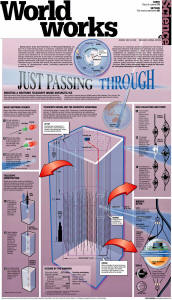|
|
|
November 07, 2007 from YouTube Website
The IceCube Neutrino Detector is a neutrino telescope currently under construction at the South Pole.
Like its predecessor, the Antarctic Muon And Neutrino Detector
Array (AMANDA), IceCube is being constructed in deep
Antarctic ice by deploying thousands of spherical optical sensors
(photomultiplier tubes, or
The sensors are deployed on "strings" of sixty modules each,
into holes in the ice melted using a hot water drill.
The neutrinos are not detected themselves. Instead, the rare instance of a collision between a neutrino and an atom within the ice is used to deduce the kinematical parameters of the incoming neutrino.
Current estimates predict the detection of about one thousand such events per day in the fully constructed IceCube detector.
Due to the high density of the ice, almost all detected products of the initial collision will be muons.
Therefore the experiment is most sensitive to the flux of muon neutrinos through its volume.
Most of these neutrinos will come from "cascades" in Earth's atmosphere caused by cosmic rays, but some unknown fraction may come from astronomical sources.
To distinguish these two sources statistically, the direction and angle of the incoming neutrino is estimated from its collision by-products.
One can generally say, that a neutrino
coming from above "down" into the detector is most likely stemming
from an atmospheric shower, and a neutrino traveling "up" from below
is more likely from a different source.
The data that IceCube will collect will also contribute to our understanding of cosmic rays, supersymmetry, weakly interacting massive particles (WIMPS), and other aspects of nuclear and particle physics.
|


